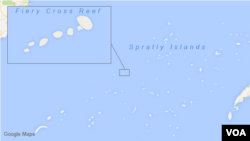China said Tuesday it will soon finish its controversial land reclamation efforts in some disputed areas of the South China Sea, but also vowed to continue building on the man-made islands that have provoked tension from rival claimants.
"The land reclamation project of China's construction on some stationed islands and reefs of Nansha Islands will be completed in the upcoming days," China's foreign ministry said in a statement, using the Chinese name for the Spratly Islands.
The ministry's brief statement, which did not provide an estimated finish date, defended the land reclamation project as being "beyond reproach" and mainly meant for civilian, not military, purposes.
"It is fair, reasonable, and lawful. It does not affect, and is not targeted against, any country and will not affect countries' freedom of navigation and overflight in the South China Sea," the statement said, echoing earlier Chinese assertions.
US objections
The United States has become increasingly outspoken in its opposition to the island-building project, which it now says takes up more than 2,000 acres on once uninhabited atolls and reefs in the strategic waterway.
Much of the island construction appears to have military purposes, including an early warning radar system, military barracks, and runway. Last month, the U.S. also said China moved artillery vehicles to the islands, although they have now been moved.
U.S. officials are worried China may restrict movement of foreign vessels and planes as it asserts its claims to the Spratly Islands, parts of which are also claimed by the Philippines, Vietnam, Malaysia, Brunei and Taiwan.
The U.S. says it does not take sides regarding the long-running sovereignty disputes, but its military, which has an extensive presence in the region, has expressed a growing boldness to directly challenge the Chinese claims.
Surveillance plane incident
Last month, a U.S. military surveillance plane, with American television journalists on board, passed near one of the reclaimed islands, prompting the Chinese Navy to issue at least eight stern warning messages.
U.S. officials recently said they are considering sending military aircraft and ships even closer to the islands. Washington has also ramped up military ties with several of China's neighbors, angering Beijing.
The island-building fits within China's wider strategy of slowly but steadily cementing its far-reaching sea claims, which it defends using ancient maps not recognized by the other claimants.











